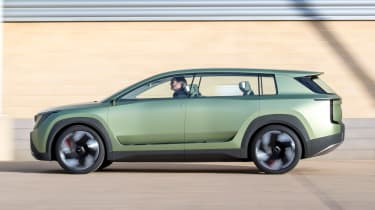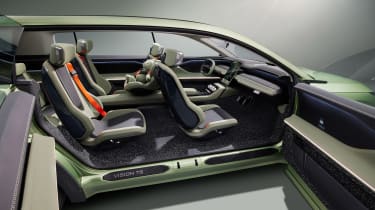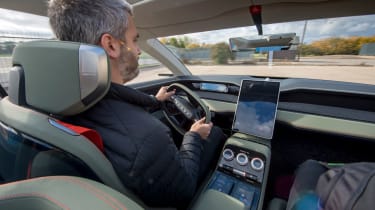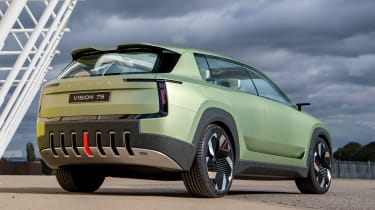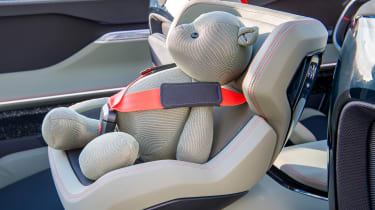Skoda Vision 7S: electric seven-seater with over 370-mile range
The electric seven-seat SUV is one of three EVs Skoda plans to launch by 2026, including an entry-level EV and compact SUV
The Skoda Vision 7S was revealed in August 2022, but we've not only had a chance to drive it, we've also spoken to the people behind the square-jawed show car. It may be a concept for now, but the Vision 7S paves the way for the Czech brand’s electric seven-seater flagship, due in 2026, and represents one of the three hotly-anticipated follow-ups to Skoda’s hugely popular Enyaq iV.
The concept car also showcases the company’s new ‘modern solid’ design language, both inside and out, as well as its new logo, which is just text opposed to the signature winged arrow we’re used to. Overall, the Vision 7S’s look is more rugged and squared-off compared to the Enyaq iV and Enyaq Coupe iV, but its pared-back design is supposed to emphasise the “simplicity and value” of the company’s new EVs, so the brand says.
Skoda’s signature sculpted bonnet design has been carried over from the Enyaq, but below that is a wider, narrowed blanked off grille. It’s called the Tech Deck, because it conceals all the myriad sensors and cameras for the concept’s driver assistance systems.
Below that is a slotted skidplate with open vertical slats that serve as air inlets, used to help cool the key components under the car and its brakes. The T-shaped LED headlight design is also new for the concept, which is replicated at the rear, with a similar design for the vertical taillights that look very similar to those on the latest Range Rover SUV.
Like a lot of concept cars, the Vision 7S features a set of rear-hinged coach doors, which is one of a handful of elements that we don’t expect to reach production. Among these is the 6+1 seating layout, which includes three rows of two seats, plus a baby seat attached to the centre console.
Inside the 7S, there’s a 14.6-inch touchscreen mounted in the centre of the dash, which if you switch from Drive to Relax mode rotates from vertical to horizontal orientation like the Fisker Ocean or BYD Atto 3’s screens. Again, this is not a feature we anticipate making the final production vehicle. You can read more about this and many of the 7S’s other features, in our first drive review below.
Switching cabin modes in the 7S also see the front-row seats rotate slightly inboard to allow their occupants to watch content more easily. Furthermore, the steering wheel and instrumental panel retract into the dash to create more room.
The steering wheel has a new two-spoke design that could very well make production, and behind it sits an 8.8-inch digital driver’s display. On the centre console you’ll find a set of rotary dials for controlling key functions, plus a dual-smartphone wireless charging pad. Some typically Skoda ‘Simply Clever’ features include backpacks integrated into the seat backs, and magnets dotted around the cabin to help hold everything from smartphones to metal water bottles securely in place.
There’s extensive use of recycled and sustainable materials throughout the cabin, too, including seat fabric made from 100% recycled polyester and dark artificial leather for the dashboard. In keeping with the removal of the chrome badge at the front, the cabin also features matte paint in all areas where there would currently be shiny plastic.
The Vision 7S uses the same MEB underpinnings as the Enyaq iV, Cupra Born and Volkswagen ID. Buzz minibus, among many others. The production version will do the same, but is likely to be the platform’s last hurrah. It'll also be one of the largest MEB cars, with the concept measuring over five metres long, with a 3,075mm wheelbase.
The concept car has an 89kWh battery, delivering a predicted range of more than 370 miles, according to Skoda. It also says the concept can recharge at speeds of up to 200kW, which is significantly faster than anything else on the MEB platform, but still behind the latest Hyundai and Kia’s charging speeds.
As we mentioned, Skoda will launch three new electric cars by 2026, in addition to facelifted versions of the Enyaq iV and Enyaq Coupe iV. The first of the three will arrive in 2024: a compact SUV designed to sit beneath the Enyaq.
Skoda will introduce an entry-level EV the following year – a sister car to the forthcoming Volkswagen ID.1 and Cupra UrbanRebel – followed by the seven-seat flagship previewed by the 7S. The production version will be the last model in the three-car line-up, and is set to arrive in 2026.
Skoda Vision 7S concept drive
Concept cars aren’t designed to be driven – that much is clear after just a couple of laps of the vacated car park we’ve been assigned for our first hands-on experience with the Skoda Vision 7S.
This million-pound one-off looks ready to roll, but on closer inspection the slow, battery-operated coach doors, clunky infotainment system and rock-hard seats show there is still work to be done. But this isn’t unusual – and in no way represents the quality of the finished product, due in 2026.
The concept is limited to little more than 15mph, and is only really capable of a mile or so before it needs plugging in via a three-pin plug underneath the car, rather than the CCS rapid-charge socket fitted to an Enyaq iV. The electric power steering is twitchy and the brakes require anticipation and a fair bit of force to operate.
But that isn’t what this drive is all about. Instead, it gives us an opportunity to experience the 7S first hand, see the technology in action and speak with the people who designed it – to see what we can and can’t expect from the production car.
We mentioned the clunky infotainment system already, though in reality the software is pretty slick. There are loads of clever features, including the ability to stream the contents of your phone via an app. It’s a bit like Apple CarPlay or Android Auto, but with a whole new level of complexity.
The clunky bit is the way the screen rotates 90 degrees at the flick of a switch. With it, the two front seats turn slightly inwards and the dash peels back. Perhaps thankfully, this isn’t a feature we’re likely to see in a Skoda any time soon, as Skoda’s Senior Designer for User Interface, Daniel Hajek tells us: “It is a hi-tech feature. If you want something reliable, maybe not. But we want to keep the vertical layout, and the ergonomics.”
Another thing destined to remain a concept frivolity is the 6+1 seating layout. While the very centre of the car may be the safest place for a child seat, the reality isn’t very practical. “It is not for production, it is only for the concept,” lead designer Franck Le Gall tells us. “Also the suicide doors – it is just for the story”.
Thankfully, the production car will have three rows of normal seats, just like a Skoda Kodiaq or Kia Sorento. So it shouldn't need the bulky centre console that runs through the 7S and encroaches on passenger space.
One thing we can take from the Vision 7S, and something that is likely to feature quite prominently in the production car, is the extensive use of sustainable materials. “We are really pushing this,” Le Gall tells us. “These sustainable materials, we are really looking at these fabrics and elements.”
We can very much expect to see a development of the 7S’s overall look, too. “The exterior is an expression of our ‘Modern Solid’ design language,” Le Galls says. “The face, and the T-shape lights; this is something we will put into production.”
But it seems Skoda wants to steer clear of the cookie-cutter approach to car design that some manufacturers have adopted in recent years. “We will keep [the lights] as a distinctive signature for Skoda,” Le Gall explains. “But we don’t want the same design on every car. We will develop a strategy – the small car will look different to the bigger car.”
Recommended

EV Deal of the Day: Dacia Spring is amazingly good value at £116 per month

EV Deal of the Day: budget-friendly Ford Capri for just £234 a month
Most Popular

EV Deal of the Day: budget-friendly Ford Capri for just £234 a month

